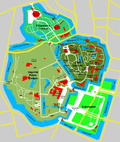Moat

A moat is a body of water around a castle or town to keep people out. The moat was introduced between 1154 and 1485. At first, moats were simple and used only for protection. Later on, moats became more complicated and were used for show.
Moats are deep, wide ditches filled with water. They were usually built near sources of water that flowed into the moats, filling them with water. The moats were filled with water for a few reasons. It made enemies swimming across the moat easy targets. It also made it impossible for enemies to dig underneath the castle walls, which was a common method of attack. It also prevented fires from destroying the castle.[1]
Origin
The word moat comes from the French word motte, which means hill. Moats were first used in the Medieval period, from 1016 to 1164. Castles were built on the top of high hills. The area at the bottom of the hill was eventually called the moat.[1]
Usage
Castle moats were usually between 5 and 40 feet deep, and they were not always filled with water. Not all moats contained water, as a simple dry, wide ditch could prove an obstacle. These were called dry moats.
In many stories, moats are filled with alligators or crocodiles. This is a myth.[2] However, moats were sometimes filled with fish or eels for food.
Moat Media
The moat surrounding Matsumoto Castle in Japan
North view of the fortress of Buhen in Ancient Egypt.
A medieval moat castle in Steinfurt, Germany
The 17th-century fortified town of Naarden, Netherlands, showing bastions projecting into the wet moat
Map of the Tokyo Imperial Palace and surrounding Gardens showing the elaborate moat system
Frozen moat of the walled city of Qufu, China
References
- ↑ 1.0 1.1 Alchin, Linda (2005), Castle Moats, retrieved 18 January 2010
- ↑ Hull, Marvin (2008), "Castle Defenses", Castles of Britain, archived from the original on 2007-01-10, retrieved 18 January 2010








